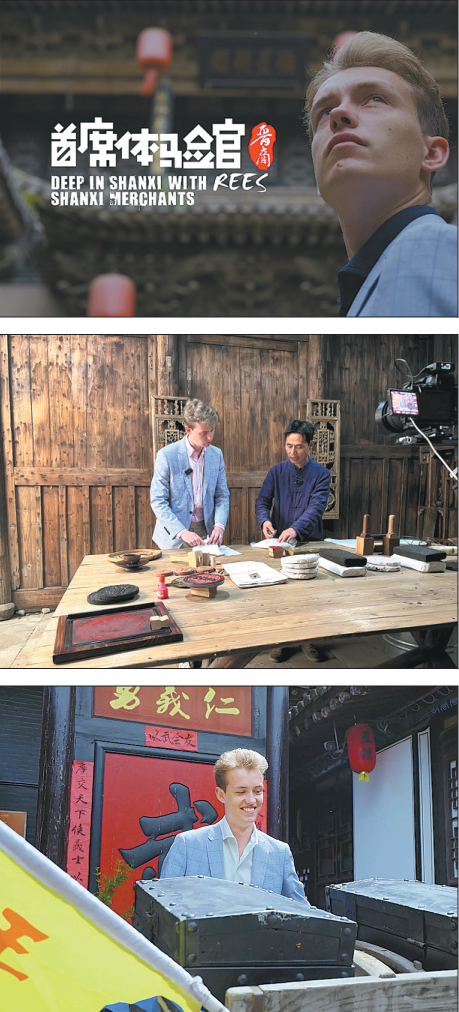Program reveals Shanxi through international eyes
Updated: 2023-09-22

The episode Starting Point, a part of the second season of Deep in Shanxi with Rees, features the tea-producing village of Xiamei in Fujian's Wuyishan city. Wuyishan is the starting point of the 13,000-kilometer tea trade route established by the Shanxi merchants. [Photo by Shanxi Radio and Television Station for China Daily]
Rees Tyrrel gets a glimpse into culture, ethics and history of famed Jinshang in popular show's second season
Rees Tyrrel is back again. After his successful first season of a show called Deep in Shanxi with Rees in September 2022, his second season went online in August and has become a hit on social media once again.
This internet influencer is a Briton teaching English at Taiyuan University of Technology in the capital city of North China's Shanxi province.
He likes to tour various parts of the province to see the cultural and natural wonders of the region, as well as its local life. And he has been given a good opportunity to make this passion a reality. In recent years, he has been able to have immersive experiences in the province thanks to a program launched by the Information Office of the Shanxi Provincial Government.
The program is called Deep in Shanxi. It invites foreigners to intensively tour Shanxi, telling stories about the province from a foreigner's point of view.
Tyrrel is no doubt one of the most successful among all the foreigners engaged in this program.
According to the organizers of the program, after the first season of his video show was put online, the hashtag of Rees has received more than 100 million views. It was also on the top search lists on such social media platforms as Douyin, Weibo and WeChat for a long period of time.
In the first season, Tyrrel's focus was on environmental and ecological improvements in Shanxi. He toured cities including Taiyuan, Datong, Jinzhong, Linfen and Yangquan, to see the improved environment and hear the stories behind the improvements from local residents.
This year, Tyrrel has shifted his focus to the famed Shanxi merchants.
Shanxi is known for its historical commerce that was developed by the Shanxi merchants, or Jinshang. It is said Jinshang merchants dominated the commercial circle in North China for about 500 years since the Ming Dynasty (1368-1644).
However, many of these successful merchants started out as small vendors who traveled as far as Russia.

From top: The second season of Deep in Shanxi with Rees has once again become a hit on the internet since it was put online on Aug 17. Tyrrel learns to make huipiao – or bank drafts – from a craftsman in Pingyao. Tyrrel examines the equipment of an old biaoju – or security guard firm – in Pingyao. [Photo by Shanxi Radio and Television Station for China Daily]
Starting point of trade
The trade in tea products was a dominant business of Jinshang merchants for centuries.
To follow in the footsteps of Jinshang merchants, Tyrrel traveled to Fujian province in East China, which used to be the leading supply region of tea to the merchants.
At Xiamei village in Fujian's Wuyishan city, Tyrrel visited the tea plantations scattered across the mountain slopes. He learned to pick up tea leaves from local farmers in the early morning.
"Obviously, tea is very widely enjoyed in the United Kingdom," Tyrrel said. "Yet I never gave a great deal of thought to where it might come from."
He added that how tea products were transported to the UK and other parts of Europe is also something worth researching.
"This (Xiamei) is where 300 years ago, a group of merchants from Shanxi province made pioneering innovations in global trade.
"They came down here to this tea-producing region from an inland province that does not produce tea. They took these products, transporting them north and then they sent them to the rest of the world."
He noted that this was "a really ingenious move", and allowed them to pioneer early globalization.
Tyrrel added that the 13,000-kilometer tea trade route established in the 17th century by the Shanxi merchants, from Fujian to Shanxi and then to Russia and the rest of Europe, is testimony to the innovative, enterprising, courageous and hardworking spirits of Jinshang.
Early banking business
In another episode, Tyrrel noticed the Jinshang merchants' pioneering efforts in creating a financial industry that led to the initial practices of China's banking business.
In the ancient city of Pingyao in central Shanxi, he found another reason behind the success of Jinshang merchants.
When visiting the premises of the famed old banking firm of Rishengchang, he noticed the wide use of huipiao, or the earliest Chinese version of bank drafts. The huipiao-related business had earned these firms the name of piaohao, or bank draft institutions.
"I've heard that they (the Jinshang merchants) would use them to enable them to do business anywhere that they traveled, paying for things conveniently," Tyrrel said.
He learned that, established some 200 years ago during the Qing Dynasty (1644-1911), Rishengchang was the earliest piaohao in China.
"Its creation aimed to replace the long-distance cash transportation services provided by biaoju – or security guard firms – with the form of bank drafts.
"The emergence of huipiao significantly changed the settlement method. With the bank drafts, China's circulation of cash entered a more rapid and convenient era," Tyrrel said.
In the video, Tyrrel told a story about Joseph Edkins – a British missionary and Sinologist who traveled to Shanxi in the late 19th century – to see "the magnitude of what the (Shanxi) merchants made. After visiting the piaohao firms, Edkins considered the business as the inception of China's banking system.
Willingness to pay back
In another video episode called A Stage Constructed for Three Years, Tyrrel got to understand another aspect of the Jinshang spirit – the merchants' willingness to pay back to the communities where they were from and their strong sense of responsibility to their hometowns and the nation.
Shanxi is the birthplace of many local operas in China so opera stages are popular structures in villages, urban communities and even in residences.
Tyrrel was informed that Shanxi is now home to more than 3,500 well-preserved ancient opera stages. But it was the one inside the Chang Family Manor in Yuci district of Jinzhong city that particularly drew his attention.
"I was here because I heard that the stage took about three years to be built," Tyrrel said.
So he wanted an answer to the question "why did that stage take three years to complete".
He anticipated a number of reasons, including complexity in structuring and insufficient investment.
But a tour guide told him that the long period of construction is because of a big drought in the late Qing Dynasty that had left millions of people in famine.
That was the period when the Chang family began construction on the opera stage in its big courtyard. "As many members of the family were successful and responsible businesspeople, they decided to build an ancestral temple that included the stage," the guide told Tyrrel. "Anyone who contributed to the construction would be provided with a meal (in addition to payment)."
So with the drought lasting for three years, the Chang family also spent the same amount of time in constructing the temple and stage, with the purpose of providing relief to the drought-affected population, according to the guide.
The Chang family was not alone. Tyrrel learned that during that period many Shanxi merchants were proactive in providing relief to those affected by the drought, supplying food, clothing and even shelter to those who had been displaced.
"The merchants pioneered a system known as 'relief through work', as well as offering people the chance to stay here," Tyrrel said. "And that's why this building took so long to complete."
He added that the system allowed the people to receive assistance with dignity and he made a comparison between the practice and the New Deal program implemented by the administration of Franklin Roosevelt, former president of the United States, in the 1930s.
He learned from locals that the Jinshang merchants' socially responsible moves also included investing in education and building infrastructure facilities like roads and bridges.
At a middle school in the county of Qixian, which was founded by renowned late Qing Dynasty merchant and diplomat Qu Benqiao, a local official told Tyrrel that Jinshang merchants had a special enthusiasm toward building schools and investing in education.
"To invest in education was the common wish of many Shanxi merchants," the official said, adding that they are respected not only for their credibility and trustworthiness but also for their patriotism and philanthropy.
In addition to shedding light on the tea business, the innovative financial operations and benevolence of Jinshang merchants, the second season of Deep in Shanxi with Rees also tapped into the pragmatism and vision of Shanxi merchants, their unity and collaboration, as well as the growth of a new generation of Shanxi merchants.
The second season went online on Aug 17, reaching a global audience in more than 20 countries and regions including the US, Canada, the UK, France, Spain and Japan, via 11 languages.
By Sept 12, the program received 1.3 billion views across the globe. It was broadcast by 1,540 media outlets throughout the world.
Sun Rui contributed to this story.



